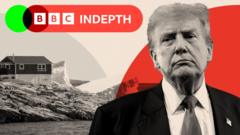Greenland, an autonomous territory of Denmark since 1979, grapples with its complex quest for independence amid historical injustices and contemporary political pressures, including interest from the United States and internal desires for self-determination.
Greenland's Independence Dilemma: Balancing History, Autonomy, and External Interests

Greenland's Independence Dilemma: Balancing History, Autonomy, and External Interests
As Greenland navigates its path towards independence, concerns about the region's colonial past and potential US influences loom large.
Article text:
On a prominent hill in Nuuk, Greenland's capital, stands a towering statue of Hans Egede, a missionary who revived connections with Northern Europe in the early 1700s, laying the foundation for Denmark's colonial legacy in the region. However, decades ago, this statue was doused in red paint, signifying the resentment among the Inuit population towards the changes that Egede and Denmark ushered into their homeland.
Having spent two years in Greenland as a child, I witnessed firsthand the complexities faced by the Inuit, including prevalent issues like alcoholism—partly a byproduct of the Danish colonial presence. While Egede's contributions brought modernization and education to Greenland, sentiments of discontent about colonial rule have simmered beneath the surface for generations.
Greenland, home to approximately 57,000 residents, has enjoyed a degree of autonomy since achieving home rule in 1979. Yet, contemporary developments have rekindled long-standing debates about the island's future. Former President Donald Trump's interest in acquiring Greenland has sparked discussions about economic security and sovereignty, leading to questions about the actual desires of Greenlanders.
Prime Minister Mette Frederiksen of Denmark has emphasized that "Greenland belongs to the Greenlanders," but recent poll findings show only 6% of Greenlanders support becoming part of the US, with the bulk (85%) preferring to remain independent from external control, indicating a strong desire for self-determination.
The past continuous influence of Denmark over Greenland has come under scrutiny. Reports reveal injustices linked to past policies, including a shocking state-sponsored contraceptive campaign affecting women without consent, labeled as a form of genocide by Greenland's Prime Minister Múte Egede. Additionally, historical child removals and adoptions have left deep emotional scars, informing a growing movement towards independence.
As Greenland grows increasingly confident in its identity, opinion polls indicate two-thirds of its population may favor a complete break from Denmark. Advocates emphasize that formal independence must not come at the cost of welfare benefits that currently rely on Danish support.
The economic dependency on Denmark raises questions about how Greenland could sustain itself. Proposals for independence suggest that developing partnerships with nations like the US for raw material extraction might secure financial stability. However, concerns about losing essential social services loom large, particularly in contrast to the US's more limited welfare programs.
The increased visibility of US interest in Greenland, especially during Trump-era discussions, compels the territory to consider alternative paths. Some Greenlanders propose a relationship of "free association," allowing for shared sovereignty with either Denmark or the US without sacrificing autonomy.
Moreover, the possibility of strengthening ties with neighboring nations like Canada, Iceland, and Norway has emerged as an appealing option for many Greenlanders who seek both stable welfare and independence aspirations.
The future of Greenland vibrates between exhilarating prospects and daunting challenges - a complex interplay influenced by its historical traumas, contemporary political maneuvering, and the quest for a unique national identity.
On a prominent hill in Nuuk, Greenland's capital, stands a towering statue of Hans Egede, a missionary who revived connections with Northern Europe in the early 1700s, laying the foundation for Denmark's colonial legacy in the region. However, decades ago, this statue was doused in red paint, signifying the resentment among the Inuit population towards the changes that Egede and Denmark ushered into their homeland.
Having spent two years in Greenland as a child, I witnessed firsthand the complexities faced by the Inuit, including prevalent issues like alcoholism—partly a byproduct of the Danish colonial presence. While Egede's contributions brought modernization and education to Greenland, sentiments of discontent about colonial rule have simmered beneath the surface for generations.
Greenland, home to approximately 57,000 residents, has enjoyed a degree of autonomy since achieving home rule in 1979. Yet, contemporary developments have rekindled long-standing debates about the island's future. Former President Donald Trump's interest in acquiring Greenland has sparked discussions about economic security and sovereignty, leading to questions about the actual desires of Greenlanders.
Prime Minister Mette Frederiksen of Denmark has emphasized that "Greenland belongs to the Greenlanders," but recent poll findings show only 6% of Greenlanders support becoming part of the US, with the bulk (85%) preferring to remain independent from external control, indicating a strong desire for self-determination.
The past continuous influence of Denmark over Greenland has come under scrutiny. Reports reveal injustices linked to past policies, including a shocking state-sponsored contraceptive campaign affecting women without consent, labeled as a form of genocide by Greenland's Prime Minister Múte Egede. Additionally, historical child removals and adoptions have left deep emotional scars, informing a growing movement towards independence.
As Greenland grows increasingly confident in its identity, opinion polls indicate two-thirds of its population may favor a complete break from Denmark. Advocates emphasize that formal independence must not come at the cost of welfare benefits that currently rely on Danish support.
The economic dependency on Denmark raises questions about how Greenland could sustain itself. Proposals for independence suggest that developing partnerships with nations like the US for raw material extraction might secure financial stability. However, concerns about losing essential social services loom large, particularly in contrast to the US's more limited welfare programs.
The increased visibility of US interest in Greenland, especially during Trump-era discussions, compels the territory to consider alternative paths. Some Greenlanders propose a relationship of "free association," allowing for shared sovereignty with either Denmark or the US without sacrificing autonomy.
Moreover, the possibility of strengthening ties with neighboring nations like Canada, Iceland, and Norway has emerged as an appealing option for many Greenlanders who seek both stable welfare and independence aspirations.
The future of Greenland vibrates between exhilarating prospects and daunting challenges - a complex interplay influenced by its historical traumas, contemporary political maneuvering, and the quest for a unique national identity.





















